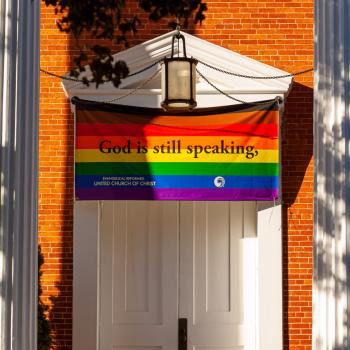There are few things that give me serious pause when it comes to understanding reality in light of the Bible and an orthodox Christian worldview. For the most part, I have achieved a kind of cognitive balance when it comes to the central claims of Christianity and the opposing views or counter evidence to those claims. Study, experience and overcoming personal trials have established in me an ever stronger epistemic certainty about the truth of the Christian faith. Of course, one learns to live with cognitive tension in any worldview one adopts. Nevertheless, there are a few things that still cause some genuine, cognitive dissonance on my part.
They are not so much the traditional problems presented in opposition to the biblical worldview. They are not things like the problem of evil and suffering or human freedom or how God can be both one God and three Persons. Those are problems for every worldview (except the last one), and they are issues that theologians and Christian philosophers have addressed for centuries. We have acceptable, if not perfect, answers to them. They may retain an air of mystery to us, but they are not totally obscure or opaque, nor logically contradictory even if paradoxical. Those who have studied Christianity carefully, can find cognitive resolution to the tension these various apologetic issues might cause. We achieve mental peace in light of what we know existentially about God in Christ and given the rich, intellectual tradition of the Church.
Some Contemporary Concerns: Aliens, Super-Technology and the Bible
The issues that do concern me– the ones that really give me pause– are far more contemporary issues. It is likely because they are so contemporary that they give me pause, because not much has been said about them yet. The theologies that would address them are still under construction. The biblical doctrines that might explain them have not yet been extracted and articulated.
One such issue of rational consideration that bothers me, even though I don’t think about it often, is the possible existence, and activity in human affairs, of extraterrestrial beings, i.e., of aliens. Another issue is that of our own “super-technologies,” ones like artificial intelligence, genetic engineering or brain transplants. These technologies seem to place us in the role of Creator on a far grander and more frightening scale than ever before in history. Even Mary Shelley in her wildest imagination would not have thought them possible. Yet the real possibility of building designer babies, or fabricating an actual “master race” through genetics, simply boggles my mind and shakes me to the core when I consider it.
Admittedly though, I have not thought about or investigated these things sufficiently to see how they might fit into an orthodox, theological system. I simply do not know enough about them. It could be, for example, that all reports of UFOs, UAPs (Unidentified Aerial Phenomena) and alien encounters are effectively hoaxes (or drug-induced delusions). If this were the case, then there simply would be no reason to get worked up over how they might fit into a biblical view of reality. After all, human beings lying about things, or meddling with their own powers of perception, is entirely compatible with a biblical worldview.
Similarly, it could be that those who are genuine experts in fields like Artificial Intelligence know that AI just is not the same as, nor ever will be equivalent to, human consciousness. Popular articles, news stories or movie characters (like The Terminator’s Skynet, or Star Trek’s Data) are but imaginative science-“fictions” that allow us to believe in things that, while not logically incoherent, are nevertheless metaphysically impossible. If this were the case, then again with regard to the biblical view of reality, there simply would not be much to see here.
Still, as history advances and new technologies develop and new phenomena present themselves to us, it has always been the role of theologians to address the new and the out-of-the-ordinary from a Christian perspective and a biblically informed metaphysics. It does not mean the theologian must hunt down and address every obscure or arcane phenomenon or consider every new piece of tech. But things that either could be massively significant if true or that are incredibly powerful advances in human creativity, are worth some theological reflection. In this article, I am only going to briefly engage with the issue of extraterrestrial life. I will save any discussion on super-technologies like AI or genetics for another time.
What is “the Phenomenon”?
Recently I watched an interview with an Australian journalist, Ross Coulthart. Coulthart does not seem to be a hack journalist. His main focus of recent investigation has been UAPs. His presentation of the data is convincing, in that he repeatedly points out the simple fact that the Pentagon and the DoD and various 5-eyes intelligence agencies are being briefed on these “possible” extraterrestrial issues. His balanced skepticism and scientific reasoning seem to motivate a restrained interpretation of the data. In fact, he is careful to the point of where he calls these sightings of possible extraterrestrial aircraft simply, “the phenomenon.” This leaves any explanation tentative, and he refuses to come to any unwarranted conclusions about whether they are actual aliens.
What seem totally plausible, and entirely true, about Coulthart’s testimony is that many government officials, intelligence professionals and military personnel, especially within the 5-eyes community, are convinced that the phenomenon of UAPs is real. In other words, it seems that more and more reports from credible eyewitnesses are coming in about unexplained and very strange aerial phenomena. Most of these credible, eyewitness reports do not make any claim on what the nature of the phenomena is. They simply report that the phenomena is outside their normal realm of experience– very much outside it.
As reports from credible eyewitnesses increase, or as we become aware of reports that have hitherto been concealed, the idea these are only hoaxes or delusions of some kind seems less and less plausible. Many of these sightings have been made by trained professionals, often military operators, working under normal conditions, fully aware of their surroundings, physically able-bodied, mentally and emotionally stable, and unencumbered by any attenuating or odd circumstances. As such, if hoax and delusion can be ruled out, at least in several cases (probably not all), then we must seek other explanations, other causes for the effect.
Two Immanent Possibilities
There are two possible explanations that could be understood as entirely immanent causes for UAPs. It should be noted here that I am only dealing with the phenomenon of UAPs, not with reports of things like human abduction, crop circles, etc. Those seem to be much more problematic. They also seem easier to explain as either delusions of some type of hoax. However, as we will see, there is another plausible explanation that the theologian can provide for experiences of personal encounters with alien beings. At this point, however, I am mainly considering the phenomena of unidentified aerial objects or crafts.
The first immanent possibility is that these objects are themselves man-made super-technologies. This is a very plausible explanation that would, for the most part, fall right in line with what we commonly accept as part of reality; human technological advancement. In other words, this explanation meshes well with our prior background knowledge, is not ad hoc, and does not multiply types of ontological entities or types of causation (Occam’s razor). These would be physical machines made by real men. The only real weakness of this explanation is the eyewitnesses reports themselves, which all seem to indicate that the phenomena witnessed seems entirely alien (meaning foreign) to any known technology. The visible quality of the phenomena really is that strange. It is often the means in which the phenomena moves or transitions that leads eyewitnesses to think that it cannot be a human-made technology.
For me, this is nevertheless my default position. It may have its problems but it is entirely reasonable. The idea that there might be “black” technology out there that only a few are aware of is not hard to believe. Moreover, that there are “information operations” or “PSYOPS” that intelligence departments conduct, even on their own populations, is a given. Even if we might never fully discern which information is dis- or misinformation and which is not, one should assume that there is always a certain type and degree of it, especially surrounding the development and production of advanced technologies. Coulthart makes this same point and he is correct to do so.
The other immanent option is that these are actual alien ships or alien technologies, which are either manned by actual alien creatures or auto-piloted by the alien technology alone. What do I mean by “alien?” Well, it would have to be something like highly advanced, intelligent, extraterrestrial beings who have the ability to travel incredible distances in virtue of possessing a technology that is simply beyond our grasp. It is the type of creature we have been dreaming of and fantasizing about for well over a hundred years. It is the subject matter of half of our films in the modern era and that spawned its own genre of literature, “science fiction.” It is the explanation that gave us Close Encounters of the Third Kind and The X-Files.
This explanation seems almost impossible. It is also the explanation that I believe would be the most difficult for Christians to square with a biblical worldview if it turned out to be true. Of course, it might depend on what kinds of aliens we discover (or that discover us); whether or not we can communicate with them, whether they also have minds like ours and, ultimately, if they also have belief in or ideas about the Creator of the universe. After all, even aliens from a distant part of the galaxy with super-technology would still be creatures– inhabitants of this universe. Their immanent existence would do nothing to discredit or diminish the plausibility of a transcendent Creator God. It would only complicate our current picture of the Creator’s activity in His creation. It could, however, turn out that an advanced alien race even possessed similar stories about God as we do, maybe ones that might even confirm a certain version of theistic belief. There was an original Star Trek episode that posited just this.
Nevertheless, this is the explanation that I find not only most difficult to believe as an earthling but also as a Christian. Still I am no astro-physicist or cosmologist, so I am not really in any position to know how plausible life on other planets might be, and how plausible it would be for advanced life to traverse great chasms of space to reach us. Prima facie it seems quite unlikely, truly something made for movies and paperback books and not for real scientific investigation. But, then again, I guess there is always the SETI project. I just haven’t heard anything about it in years. Still one can’t help but wonder about the value of financing such things.
A Third, Transcendent Explanation (With Biblical Warrant)
Early in Coulthart’s interview, he makes a brief statement that should immediately catch the attention of any theist, biblical Jew or Christian. Coulthart mentions the book of Ezekiel in relation to “the phenomenon.” This is a point worth noting, for the first chapter of Ezekiel almost reads like a modern-day Sci-Fi novel. Later in the interview, the journalist mentions that “the phenomenon” seems to have the capacity to alter human perception, or present itself in different ways to different people. Again, while the phenomenon could be in some cases a delusion or hoax, and perhaps in others the more plausible explanation of an advanced, human technology, this feature of the phenomenon begins to make it sound like something quite familiar to any student of the Bible.
Visions in the Bible can have three sources: God, angels or demon gods (elohim that are not YHWH). Of course, the source of the latter two are ultimately the first. In Ezekiel, the prophet tells us that he witnessed something like the “appearance of the likeness of the Lord’s glory” (Ezek 1:28b). I have often used this passage of Scripture to teach student’s about the nature of God’s holiness. For here, as grand, as magnificent, as mind-blowing as Ezekiel’s vision is, it is merely a copy of a copy of the real thing. Or, better said, it is the image of the image of God’s glory, three steps removed from the actual things in itself. Further, we know why this experience of God’s glory must be mediated by degrees, because any direct encounter with God’s essence would be the end of the creature beholding it. For “no man can see God and live.” (Exod 33:20) And, indeed, according to Jesus, no man had seen God until His incarnation (Jn 14:19).
But there are other entities apart from God Himself that can manifest themselves to men in spectacular ways. There are the creatures that appear within the vision of God, the four-faced, four winged, somewhat human looking Seraphim. These creatures even seem to move in a way similar to how many describe the movements of UAPs:
The creatures did not turn as they moved; each one went straight ahead….Each creature went straight ahead. Wherever the Spirit wanted to go, they went without turning as they moved.
Ezekiel goes on to describe the creatures as “like the appearance of blazing coals of fire or like torches.” There is “fire moving back and forth between the living creatures” and “it was bright, with lightning coming out of it.” He goes on, “The creatures were darting back and forth like flashes of lightning.”
It only gets more and more bizarre from there. The point being, however, that if the Bible is true on other fundamental issues of ontology, which it is, then there are creatures that are immaterial yet active. Or, minimally, there are creatures that are normally invisible to human perception, but that can make themselves visible, even visible in ways intelligible to the viewer (as composites, for example, of common natural objects or human artifacts like wings, eagles, and hooves or torches). While God is ultimately the source of these other creatures, being the Creator of all things, these creatures could manifest themselves to us in accordance with God’s will or, perhaps in a limited sense, contrary to His will, meaning contrary to His perfect will (not God’s permissive will).
In the New Testament, for example, Paul tells us that even Satan, the prince of demons and father of lies, can masquerade as “an angel of light” (2 Cor 11:14). While it is important to understand this Pauline claim as relating to Satan deceiving us primarily with regard to truth and goodness, like the false teachers Paul has just mentioned; still, who is to say that it does not also mean that the immaterial, agentive creature, Satan, can actually manifest himself perceptually as a creature of light? We know from both the Bible and from experience that Satan, likely one of the divine counsel (see Heiser, The Unseen Realm) is a metaphysical being, not merely a metaphorical one. This explanation of immaterial beings manifesting themselves in various ways to human beings, may also work as a partial explanation to the other claim about aliens, namely to personal abductions.
And so we do have another explanation for UAPs and perhaps even for personal encounters with “aliens” that comports with the biblical worldview: “the phenomena” are manifestations of spiritual beings, either angels or demons, that while not entirely transcendent like their source, God, are nevertheless not totally immanent. They are not material beings that evolved through secondary causal processes, as we imagine aliens like “E.T.” would be. They are spirits and, being spirits, have been with us from the very beginning.













